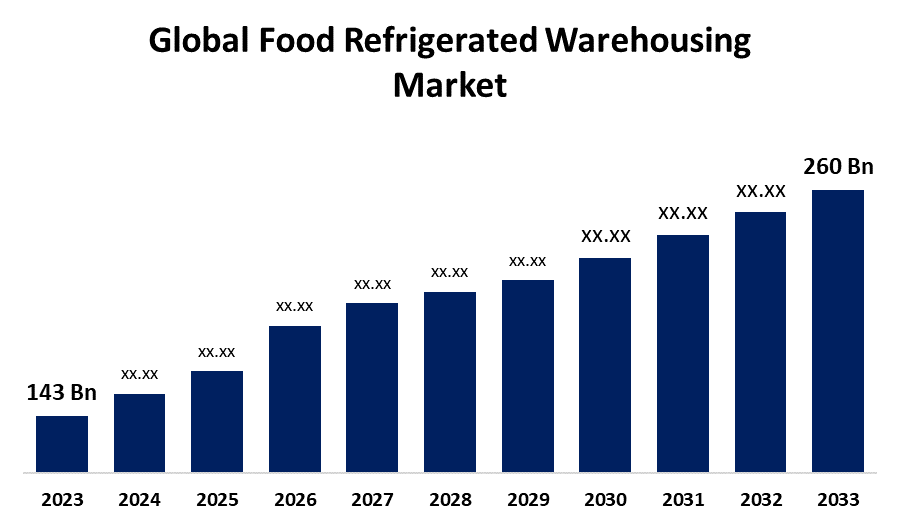Global Food Refrigerated Warehousing Market Size, Share, and COVID-19 Impact By Temperature Range (Chilled and Frozen), By Technology (Blast Freezing, Vapor Compression, Evaporative Cooling, and Others), By Warehouse Type (Public and Private), By Region (North America, Europe, Asia-Pacific, Latin America, Middle East, and Africa), Analysis and Forecast 2023 - 2033.
Industry: Food & BeveragesGlobal Food Refrigerated Warehousing Market Insights Forecasts to 2033
- The Global Food Refrigerated Warehousing Market Size was estimated at USD 143 Billion in 2023
- The Market Size is expected to grow at a CAGR of around 6.16% from 2023 to 2033
- The Worldwide Food Refrigerated Warehousing Market Size is Expected to Reach USD 260 Billion by 2033
- Asia Pacific is expected to grow the fastest during the forecast period.

Get more details on this report -
The Global Food Refrigerated Warehousing Market was worth around USD 143 Billion in 2023 and is predicted to grow to around USD 260 Billion By 2033, with a compound annual growth rate (CAGR) of 6.16% between 2023 and 2033. The market is driven by the growing need for perishable food items and efficient cold storage technologies. The expanding global population, urbanization, and shifting dietary trends among consumers are key growth drivers that push the market forward.
Market Overview
The food refrigerated warehousing market refers to the involves the storage of perishable commodities in temperature-managed facilities for preserving freshness, safety, and shelf life. Such specialized warehouse facilities employ methods such as blast freezing and monitoring systems, working for industries that include food processing, retailing, and logistics, and act as a pivot in the worldwide cold chain supply system. The market is driven by the food refrigerated warehousing industry offers many opportunities for innovation and growth. The capability to store and distribute perishable products at regulated temperatures guarantees a consistent and predictable flow of goods from producers to retailers. Such predictability is essential in addressing consumer demand for fresh and varied food products year-round. Furthermore, such facilities also perform a key role in facilitating world trade by providing a vehicle for the storage and transportation of food products across international borders, so that the world food market becomes more integrated and dynamic. Additionally, the market for the use of sustainable and energy-efficient refrigeration technologies. Increasing concern about climate change and sustainability in the environment has created a growing demand for green cold storage options.
Report Coverage
This research report categorizes the food refrigerated warehousing market based on various segments and regions, forecasts revenue growth, and analyzes trends in each submarket. The report analyzes the key growth drivers, opportunities, and challenges influencing the food refrigerated warehousing Market. Recent market developments and competitive strategies such as expansion, type launch, development, partnership, merger, and acquisition have been included to draw the competitive landscape in the market. The report strategically identifies and profiles the key market players and analyzes their core competencies in each sub-segment of the food refrigerated warehousing market.
Global Food Refrigerated Warehousing Market Report Coverage
| Report Coverage | Details |
|---|---|
| Base Year: | 2023 |
| Forecast Period: | 2023-2033 |
| Forecast Period CAGR 2023-2033 : | 6.16% |
| Historical Data for: | 2019-2022 |
| No. of Pages: | 230 |
| Tables, Charts & Figures: | 102 |
| Segments covered: | By Temperature Range, By Technology, By Warehouse Type, By Region |
| Companies covered:: | Americold Logistics, LLC, AGRO Merchants Group, LLC, Nichirei Logistics Group Inc., Kloosterboer Group, Burris Logistics, Congebec Logistics Inc., Interstate Warehousing, Inc., Trenton Cold Storage Inc., Conestoga Cold Storage, RLS Logistics, Cold Storage Solutions, Snowman Logistics Ltd., and other key vendors. |
| Pitfalls & Challenges: | COVID-19 Empact, Challenge, Future, Growth, & Analysis |
Get more details on this report -
Driving Factors
The food refrigerated warehousing market is driven by some major trends. The major drivers of growth for the food refrigerated warehousing market are the rising demand for fresh and frozen food items globally. Furthermore, with a growing consciousness of health and nutrition, customers are moving towards fresh fruits and vegetables, dairy, and high-protein meat and seafood, which need rigorous temperature-controlled storage. Additionally, the growth of the e-commerce industry, especially in grocery and food ordering for delivery, has increased the demand for advanced refrigerated warehousing solutions to address the logistical needs of internet-based retailers. Moreover, technological innovation in refrigeration and cold storage technologies is another key driver for market expansion. Technologies like energy-saving refrigeration equipment, cutting-edge blast freezing, and the latest vapor compression technologies make refrigerated warehouses more efficient in their storage capacity and operations.
Restraining Factors
The food refrigerated warehousing market encounters certain difficulties that would restrain its development. The significant up-front cost of establishing and running high-tech refrigerated warehouses. The expense of buying and installing state-of-the-art refrigeration machinery, power-saving devices, and temperature-sensing technologies can be too high for some companies, especially SMEs. Moreover, the maintenance and operating expenses, such as energy use and regulatory issues, continue to test available finances.
Market Segmentation
The food refrigerated warehousing market share is classified into temperature, technology, and warehouse type.
- The frozen segment held the largest share of the market in 2023 and is projected to grow at a substantial CAGR during the forecast period.
Based on temperature range, the food refrigerated warehousing market is segmented into chilled and frozen. Among these, the frozen segment held the largest share of the market in 2023 and is projected to grow at a substantial CAGR during the forecast period. The segmental growth is due to the increasing consumption of frozen foods, which provide convenience and longer shelf life. Breakthroughs in freezing processes, including blast freezing, have significantly increased the effectiveness and efficacy of this segment in maintaining the quality and safety of frozen products.
- The blast freezing segment accounted for a significant share in 2023 and is anticipated to grow at a remarkable CAGR during the forecast period.
Based on technology, the global food refrigerated warehousing market is categorized into blast freezing, vapor compression, evaporative cooling, and others. Among these, the blast freezing segment accounted for a significant share in 2023 and is anticipated to grow at a remarkable CAGR during the forecast period. The growth is drive by quickly lowering the temperature of food items to keep them in good condition and prolong shelf life. Moreover, it is especially useful for meat, fish, seafood, and bakery items since it avoids the growth of big ice crystals that destroy cell structures and impact texture.
- The public segment accounted for a significant share in 2023 and is anticipated to grow at a remarkable CAGR during the forecast period.
Based on warehouse type, the global food refrigerated warehousing market is categorized into public and private. Among these, the public segment accounted for a significant share in 2023 and is anticipated to grow at a remarkable CAGR during the forecast period. The segment's growth is attributed mainly to these public warehouses are especially sought after by small and medium-sized enterprises (SMEs) in need of adaptable storage without necessarily requiring high levels of capital expenditure. Furthermore, the need for public refrigerated warehouses is increasing, stimulated by the increasing number of SMEs and the growth of the e-commerce industry.
Regional Segment Analysis of the Food Refrigerated Warehousing Market
- North America (U.S., Canada, Mexico)
- Europe (Germany, France, U.K., Italy, Spain, Rest of Europe)
- Asia-Pacific (China, Japan, India, Rest of APAC)
- South America (Brazil and the Rest of South America)
- The Middle East and Africa (UAE, South Africa, Rest of MEA)
North America is anticipated to hold the largest share of the food refrigerated warehousing market over the predicted timeframe.

Get more details on this report -
North America is anticipated to hold the largest share of the food refrigerated warehousing market over the predicted period. This dominance is due to the rising demands for frozen food and convenience products, along with the growth in the e-commerce industry, the food refrigerated warehousing market in North America is on the rise. Furthermore, the sustainability and energy-efficient focus of the region is also driving innovation and investment in sophisticated cold storage solutions.
Asia-Pacific is expected to grow rapidly in the food refrigerated warehousing market during the forecast period. The market in the region is driven by the growing population, increasing disposable incomes, and the rising demand for high-quality food items. China, India, and Japan are driving this growth, and there is tremendous investment in cold storage facilities and technology. In addition, industry players are increasing their refrigerated warehouse facilities in the region.
the continuing investments in infrastructure redevelopment and industrial automation. Moreover, within North America, the United States and Canada are continually investing in big-ticket infrastructure initiatives and smart city expansion, fueling the need for crane rental.
Competitive Analysis:
The report offers an appropriate analysis of the key organization markets/companies involved within the food refrigerated warehousing market, along with a comparative evaluation primarily based on their type of offering, business overviews, geographic presence, business strategies, segment market share, and SWOT analysis. The report also provides an elaborate analysis focusing on the current news and developments of the companies, which includes type development, innovations, joint ventures, partnerships, mergers & acquisitions, strategic alliances, and others. This allows for the evaluation of the overall competition within the market.
List of Key Companies
- Americold Logistics, LLC
- AGRO Merchants Group, LLC
- Nichirei Logistics Group Inc.
- Kloosterboer Group
- Burris Logistics
- Congebec Logistics Inc.
- Interstate Warehousing, Inc.
- Trenton Cold Storage Inc.
- Conestoga Cold Storage
- RLS Logistics
- Cold Storage Solutions
- Snowman Logistics Ltd.
- Others
Key Target Audience
- Market Players
- Investors
- End-users
- Government Authorities
- Consulting And Research Firm
- Venture capitalists
- Value-Added Resellers (VARs)
Recent Development
- In September 2023, Prozo, a supply chain company with full-stack capabilities, launched its second enterprise-level cold storage facility at Krishnapatnam, Tamil Nadu. It is well-positioned close to key seafood markets on the East Coast of Tamil Nadu and Andhra Pradesh.
Market Segment
This study forecasts revenue at the global, regional, and country levels from 2023 to 2033. Spherical Insights has segmented the food refrigerated warehousing market based on the below-mentioned
Global Food Refrigerated Warehousing Market, By Temperature Range
- Chilled
- Frozen
Global Food Refrigerated Warehousing Market, By Technology
- Blast Freezing
- Vapor Compression
- Evaporative Cooling
- Others
Global Food Refrigerated Warehousing Market, By Warehouse Type
- Public
- Private
Global Food Refrigerated Warehousing Market, By Regional Analysis
- North America
- US
- Canada
- Mexico
- Europe
- Germany
- UK
- France
- Italy
- Spain
- Russia
- Rest of Europe
- Asia Pacific
- China
- Japan
- India
- South Korea
- Australia
- Rest of Asia Pacific
- South America
- Brazil
- Argentina
- Rest of South America
- Middle East & Africa
- UAE
- Saudi Arabia
- Qatar
- South Africa
- Rest of the Middle East & Africa
Frequently Asked Questions (FAQ)
-
1. What is the CAGR of the food refrigerated warehousing market over the forecast period?The global food refrigerated warehousing market is projected to expand at a CAGR of 6.16% during the forecast period.
-
2. What is the market size of the food refrigerated warehousing market?The global food refrigerated warehousing market size is expected to grow from USD 143 billion in 2023 to USD 260 billion by 2033, at a CAGR of 6.16% during the forecast period 2023-2033.
Need help to buy this report?